Answer
419.1k+ views
Hint: The external work required to move a charge in an electric field depends only upon the change in the electric potential of the charge and not the path taken by the charge. Equipotentials are the boundaries or regions where a charge will have the same electric potential.
Formula used:
$W=q\Delta V$
Complete step by step answer:
The magnitude of work done by an external agent while moving a charge from point $A$ to point $B$ depends upon the difference of the electric potential of the points.
The magnitude of work done $W$ by an external agent to move a charge $q$ through the potential difference $\Delta V$ is given by
$W=q\Delta V$ --(1)
As we see in the figure, in all cases the charge is moved from point $A$ which has a potential of $10V$ to point $B$ which has a potential of $40V$. Hence, the change in the electric potential in all these cases is the same, that is, $40V-10V=30V$.
Hence, since the change in potential $\Delta V$ is the same in all cases, using (1), we can say that the work done in all the cases will be the same.
Hence, the correct option is C) In all the cases the work done is the same.
Note: The work done in moving a charge is dependent on the difference in the electric potential of the final and initial points as explained above. This is because the electrostatic forces are conservative forces, that is, the work done by them only depends upon the initial and final positions and not the path taken by the body. This is similar to the force of gravity and the work done by gravity (change in gravitational potential energy) which only depends upon the initial and final positions of the body and not the path taken to reach the final position from the initial position.
Formula used:
$W=q\Delta V$
Complete step by step answer:
The magnitude of work done by an external agent while moving a charge from point $A$ to point $B$ depends upon the difference of the electric potential of the points.
The magnitude of work done $W$ by an external agent to move a charge $q$ through the potential difference $\Delta V$ is given by
$W=q\Delta V$ --(1)
As we see in the figure, in all cases the charge is moved from point $A$ which has a potential of $10V$ to point $B$ which has a potential of $40V$. Hence, the change in the electric potential in all these cases is the same, that is, $40V-10V=30V$.
Hence, since the change in potential $\Delta V$ is the same in all cases, using (1), we can say that the work done in all the cases will be the same.
Hence, the correct option is C) In all the cases the work done is the same.
Note: The work done in moving a charge is dependent on the difference in the electric potential of the final and initial points as explained above. This is because the electrostatic forces are conservative forces, that is, the work done by them only depends upon the initial and final positions and not the path taken by the body. This is similar to the force of gravity and the work done by gravity (change in gravitational potential energy) which only depends upon the initial and final positions of the body and not the path taken to reach the final position from the initial position.
Recently Updated Pages
What are biodiversity hotspots Name the biodiversity class 10 biology CBSE

What are biodegradable substances Give two example class 10 biology CBSE

Area of retina devoid of rods and cones is A Yellow class 10 biology CBSE

What are antibiotics Give five examples of bacteria class 10 biology CBSE

What are analogous organs Give two examples class 10 biology CBSE

Why are alluvial soils also called riverine soils class 10 biology CBSE

Trending doubts
Difference Between Plant Cell and Animal Cell

Which are the Top 10 Largest Countries of the World?

Fill the blanks with the suitable prepositions 1 The class 9 english CBSE

Give 10 examples for herbs , shrubs , climbers , creepers

Difference between Prokaryotic cell and Eukaryotic class 11 biology CBSE

Select the word that is correctly spelled a Twelveth class 10 english CBSE

Fill the blanks with proper collective nouns 1 A of class 10 english CBSE

Change the following sentences into negative and interrogative class 10 english CBSE

The Buddhist universities of Nalanda and Vikramshila class 7 social science CBSE




